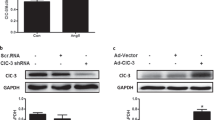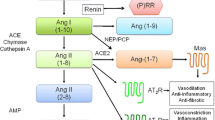Abstract
Angiotensin II (Ang II) dysregulation has been determined as cause or an effect of many diseases. The relationship between Ang II and reactive oxygen species (ROS), which are generated by enzymes in the nicotinamide adenine dinucleotide phosphate oxidase (NOX) family, has been the focus of many researchers for years. Inflammation in response to the activities of various NOXs with differing time-dependent characteristics was reported. It is still unclear how these factors interplay over the course of the inflammatory response and how signal transduction through mitogen-activated protein kinase (MAPK) pathways. Our study collected data on the effects of Ang II on human umbilical vascular endothelial cells (HUVECs) over a comprehensive time period. Our results demonstrated that NOXs had two time-dependent reactions in response to Ang II stimulation via MAPK pathways. First, ROS was produced only during the early inflammatory phase. NOX4 promoted more rapid generation of H2O2 via the JNK pathway than generation of O2·− via ERK1/2 and p38 pathways. During both the early and late phases of the inflammatory response, NOX4 activity was transduced through the JNK pathway, whereas NOX1 and NOX2 signals were transmitted via the ERK1/2 and p38 pathways. Signal transduction via ROS generation was more likely during the early phase of the inflammatory response, and increased cytokine levels were more likely induced by the late phase of the inflammatory response.







Similar content being viewed by others
References
Cat, A.N.D., A.C. Montezano, D. Burger, and R.M. Touyz. 2013. Angiotensin II, NADPH oxidase, and redox signaling in the vasculature. Antioxid Redox Signal 19(10): 1110–1120.
Anilkumar, N., R. Weber, M. Zhang, A. Brewer, and A.M. Shah. 2008. Nox4 and Nox2 NAPDH oxidases mediate distinct cellular redox signaling responses to agonist stimulation. Arterioscler Thromb Vasc Biol 28: 1347–1354.
Shatanawi, A., M.J. Romero, J.A. Iddings, et al. 2011. Angiotensin II-induced vascular endothelial dysfunction through RhoA/Rho kinase/p38 mitogen-activated protein kinase/arginase pathway. Am J Physiol Cell Physiol 300: C1181–C1192.
Zhang, X., M. Wu, H. Jiang, et al. 2014. Angiotensin II upregulates endothelial lipase expression via the NF-kappa B and MAPK signaling pathways. PLOS ONE 9(9): e107634.
Qiu, Y., L. Tao, C. Lei, et al. 2015. Downregulating p22phox ameliorates inflammatory response in angiotensin II-induced oxidative stress by regulating MAPK and NF-κB pathways in ARPE-19 cells. Sci Rep 29(5): 14362.
Guo, R.-W., L.-X. Yang, M.-Q. Li, B. Liu, and X.-M. Wang. 2006. Angiotensin II induces NF-κB activation in HUVEC via the p38MAPK pathway. Peptides 27: 3269–3275.
Balla, S., M.B. Nusair, and M.A. Alpert. 2013. Risk factors for atherosclerosis in patients with chronic kidney disease: recognition and management. Curr Opin Pharmacol 13: 192–199.
Alvarez, A., M. Cerda-Nicolas, Y.N.A. Nabah, et al. 2004. Direct evidence of leukocyte adhesion in arterioles by angiotensin II. Blood 104: 402–408.
Nabah, Y.N.A., M. Losada, R. Estelles, et al. 2007. CXCR2 blockade impairs angiotensin II-induced CC chemokine synthesis and mononuclear leukocyte infiltration. Arterioscler Thromb Vasc Biol 27: 2370–2376.
Konior, A., A. Schramm, M. Czesnikiewicz-Guzik, and T.J. Guzik. 2014. NADPH oxidases in vascular pathology. Antioxid Redox Signal 20(17): 2794–2807.
Zhang, L., A. Zalewski, Y. Liu, et al. 2003. Diabetes-induced oxidative stress and low-grade inflammation in porcine coronary arteries. Circulation 108: 472–478.
Forman, H.J., and M. Torres. 2002. Reactive oxygen species and cell signaling-respiratory burst in macrophage signaling. Am J Resp Crit Care Med 166: S4–S8.
Dikalov, S.I., A.E. Dikalova, A.T. Bikineyeva, H.H.H.W. Schmidt, D.G. Harrison, and K.K. Griendling. 2008. Distinct roles of Nox1 and Nox4 in basal and angiotensin II-stimulated superoxide and hydrogen peroxide production. Free Radic Biol Med 45: 1340–1351.
Mendez, J.I., W.J. Nicholson, and W.R. Taylor. 2005. SOD isoforms and signaling in blood vessels: evidence for the importance of ROS compartmentalization. Arterioscler Thromb Vasc Biol 25: 887–888.
Rodriguez-Rocha, H., A. Garcia-Garcia, C. Pickett, et al. 2014. Compartmentalized oxidative stress in dopaminergic cell death induced by pesticides and complex I inhibitors: distinct roles of superoxide anion and superoside dismutases. Free Radic Biol Med 61: 370–383.
Wu, R.-F., Z. Ma, Z. Liu, and L.S. Terada. 2010. Nox4-derived H2O2 mediates endoplasmic reticulum signaling through local Ras activation. Mol Cell Biol 30(14): 3553–3568.
Schroder, K., M. Zhang, S. Benkhoff, et al. 2012. Nox4 is a protective reactive oxygen species generating vascular NADPH oxidase. Circ Res 110: 1217–1225.
Stolk, J., T.J. Hiltermann, J.H. Dijkman, and A.J. Verhoeven. 1994. Characteristics of the inhibition of NADPH oxidase activation in neutrophils by apocynin, a methoxy-substituted catechol. Am J Resp Cell Mol Biol 11(1): 95–102.
Schulz, E., and T. Munzel. 2008. NOX5, a new “radical” player in human atherosclerosis? J Am College Cardiol 52(22): 1810–1812.
Brandes, R.P., N. Weissmann, and K. Schroder. 2014. Nox family NADPH oxidases: molecular mechanisms of activation. Free Radic Biol Med 76: 208–226.
Bedard, K., and K.-H. Krause. 2007. The NOX family of ROS-generating NADPH oxidases: physiology and pathophysiology. Physiol Rev 87(1): 245–313.
Rabb, H., M.D. Griffin, D.B. McKay, et al. 2015. Inflammation in AKI: current understanding, key questions, and knowledge gaps. J Am Soc Nephrol 27(2): 371–379.
Pescatore, L.A., D. Bonatto, F.L. Forti, A. Sadok, H. Kovacic, and F.R.M. Laurindo. 2012. Protein disulfide isomerase is required for platelet-derived growth factor-induced vascular smooth muscle cell migration, Nox1 NADPH oxidase expression, and RhoGTPase activation. J Biol Chem 287(35): 29290–29300.
Wu J-S, Tsai H-D, Cheung W-M, Hsu CY, Lin T-N (2015) PPAR-γ ameliorates neuronal apoptosis and ischemic brain injury via suppressing NF-κB-driven p22phox transcription. Mol Neurobiol 1–20
Kim, H.G., Y.R. Kim, J.H. Park, et al. 2015. Endosulfan induces COX-2 expression via NADPH oxidase and the ROS, MAPK, and Akt pathways. Arch Toxicol 89(11): 2039–2050.
Zhao, Q.D., S. Viswanadhapalli, P. Williams, et al. 2015. NADPH oxidase 4 induces cardiac fibrosis and hypertrophy through activating Akt/mTOR and NFκB signaling pathways. Circulation 131: 643–655.
Gupta, S.C., R. Singh, R. Pochampally, K. Watabe, and Y.-Y. Mo. 2014. Acidosis promotes invasiveness of breast cancer cells through ROS-AKT-NF-κB pathway. Oncotarget 5(23): 12070–12082.
Yamamoto, S., S. Niida, E. Azuma, et al. 2015. Inflammation-induced endothelial cell-derived extracellular vesicles modulate the cellular status of pericytes. Sci Rep 5: 8505.
Wang, Y.-F., Y.-J. Hsu, H.-F. Wu, et al. 2016. Endothelium-derived 5-methoxytryptophan is a circulating anti-inflammatory molecule that blocks systemic inflammation. Circ Res.
Flemming, S., N. Burkard, Melanie, et al. 2015. Soluble VE-cadherin is involved in endothelial barrier breakdown in systemic inflammation and sepsis. Cardiovasc Res 107(1): 32–44.
Mylroie, H., O. Dumont, A. Bauer, et al. 2015. PKCε-CREB-Nrf2 signalling induces HO-1 in the vascular endothelium and enhances resistance to inflammation and apoptosis. Cardiovasc Res 106(3): 509–591.
Calvayrac, O., R. Rodriguez-Calvo, I. Marti-Pamies, et al. 2015. NOR-1 modulates the inflammatory response of vascular smooth muscle cells by preventing NFκB activation. J Mol Cell Cardiol 80: 34–44.
Freise, C., and U. Querfeld. 2015. The lignan(+)-episesamin interferes with TNF-α-induced activation of VSMC via diminished activation of NF-κB, ERK1/2 and AKT and decreased activity of gelatinases. Acta Physiol 213(3): 642–652.
Orriols, M., S. Varona, I. Marti-Pamies, et al. 2016. Down-regulation of Fibulin-5 is associated with aortic dilation: role of inflammation and epigenetics. Cardiovasc Res 110(3): 431–442.
Brandes, R.P., N. Weissmann, and K. Schroder. 2014. Nox family NADPH oxidases in mechano-transduction: mechanisms and consequences. Antioxid Redox Signal 20(6): 887–898.
Acknowledgments
We give our sincere thanks to Lixue Chen, Weixue Tang, Jingmei Xie, Yao Xiao, Xiaojuan Deng, and Guangchen Qin at the central laboratory of the First Affiliated Hospital of Chongqing Medical University for their assistance while we conducted our experiments.
Author Contributions
X. Zhang conceived the study and designed the experiments. X. Zhang, J. Yang and X.Y. Yu performed all of the experiments. X. Zhang analyzed the data and wrote the manuscript. S. Cheng assisted in editing the figures. H. Gan and Y.F. Xia reviewed and revised the paper.
Author information
Authors and Affiliations
Corresponding author
Ethics declarations
Conflict of Interest
The authors declare that they have no competing interests.
Rights and permissions
About this article
Cite this article
Zhang, X., Yang, J., Yu, X. et al. Angiotensin II-Induced Early and Late Inflammatory Responses Through NOXs and MAPK Pathways. Inflammation 40, 154–165 (2017). https://doi.org/10.1007/s10753-016-0464-6
Published:
Issue Date:
DOI: https://doi.org/10.1007/s10753-016-0464-6




